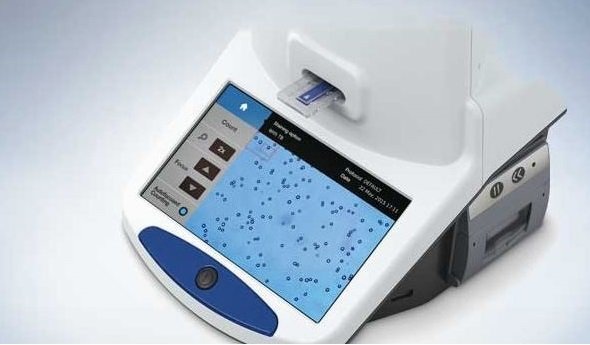
image courtesy: Report Herald
Automated cell counters are electronic devices that can automatically count the cells of humans, animals, plants, bacteria, viruses, as well as the cells of other origins. The cell counting procedure starts with the loading of a sample into an automated cell counter, which is then passed through a narrow tube. Based on the software-guided analysis, the automated cell counter uses either optical or electrical sensors to count the number of cells that successfully pass through the tube. Depending upon the device models, the time taken from sample loading to result in output can vary from 30 seconds to 5 minutes.
For medical and research purposes, automated cell counters can be used for blood or urine analysis, as well as to determine the cell count to check the viability of the cultured cell lines meant for research activities. Some automated cell counters are used for blood analysis and others for urinalysis. The features that are unique to different automated cell counters include sample size, cell type, and capacity to differentiate between live and dead cells.
The market for automated cell counters comprises of different types of systems and reagents. In the automated cell counter market, the systems are available in the form of table-top devices and devices that vary based on their image analysis technology. According to a study, among all the systems, coulter systems were the leading systems in the global automated cell counters market in terms of revenue with a global market share of 33% in 2018.
Automated Cell Counter Market: Products and Market Overview
In recent years, automated cell counters have become attractive alternative devices to manual cell counting devices. The greater demand for automated cell counters can be attributed to their accurate and reliable results in a fraction of the time. Furthermore, these devices also significantly reduce manpower dependency and cell count variance. Several studies on the efficiency comparison of manual and automated cell counters have shown that the latter provides improved cell counting reproducibility and accuracy.
Major players in the automated cell counter market are concentrating their efforts on research and development to introduce new products into the market, which are more cost-effective and affordable for small labs. In addition, several technological advancements in cell imaging technology are currently under process, which is likely to find applications in a wide range of clinical biomedical studies.
Macroeconomic indicators, such as favourable government policies for start-up companies for setting up manufacturing facilities, are estimated to fuel the growth of the automated cell counter market. Moreover, the increase in the number of healthcare institutions and diagnostic centres is expected to boost the demand for automated cell counters. Furthermore, the growth of the healthcare sector in emerging nations is estimated to fuel the growth of the automated cell counters market. For instance, according to the World Bank Group, in 2014, China’s healthcare expenditure was 5.5% of the GDP, and the country’s healthcare expenditure is expected to double by 2020.
Automated Cell Counter Market: Segmentation
The automated cell counters market report offers a comprehensive taxonomy of the automated cell counters market based on product types, applications, end-users, and regions.
Based on the product type, the global automated cell counter market is segmented into systems and reagents & accessories. The automated cell counter systems can be further classified into coulter counters, haemocytometers, flow cytometers, and image-based cell counters.
Based on application, the automated cell counter market is further classified into blood analysis, urine analysis, microbial cell count, cell-line viability, and others. With a wide range of applications and opportunities in the medical as well as research fields, the automated cell counters market offers significant potential for small and emerging players to invest in the market.
The automated cell counter market has been analysed across the regions of North America, Latin America, Europe, East Asia, South Asia, Oceania, and the Middle East & Africa. Due to the high prevalence of HIV and the high incidence of cancer, various countries, such as India and China, as well as the North America region, are estimated to be the fastest-growing regional markets for automated cell counters and are poised to offer significant opportunities. With a large number of ongoing cell-line research and cancer studies, the demand for automated cell counters is estimated to grow significantly in European countries as well. Moreover, mergers & acquisitions and distribution & collaboration agreements by key manufacturers in the automated cell counter market are also among factors estimated to fuel the growth of the market.
The automated cell counter market report tracks some of the key companies operating in the global automated cell counter market, which include Danaher Corporation, ChemoMetec A/S, F. Hoffmann-La Roche Ltd., Nexcelom Bioscience LLC, Oxford Optronix Ltd., ALIT Life Science Co., Ltd., Luminex Corporation, and Merck KGaA, among others.




